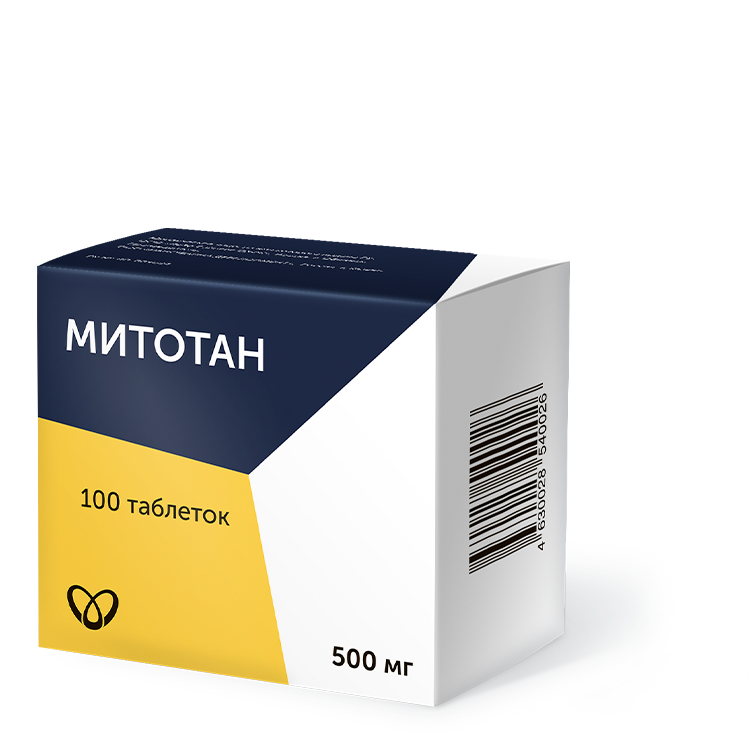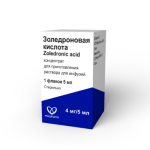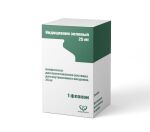Mitotane
ТаблеткиAntineoplastic agent

Indications
Symptomatic treatment of progressive (inoperable, metastatic, or recurrent) forms of adrenal cortex cancer.
The effect of mitotane on hormone-producing cancer of the adrenal cortex has not been established.
Contraindications
- Hypersensitivity to the active substance or any excipient included in the tablets
- Pregnancy
- Children under 3 years of age
- Breastfeeding period
- Severe renal and/or hepatic insufficiency
- Simultaneous administration of spironolactone
With caution
- Fatness
- Hypofunction of the adrenal cortex
- Renal and/or hepatic insufficiency of mild to moderate severity
- Pregnancy
- Concomitant use with anticonvulsants, rifabutin, rifampicin, griseofulvin, St. John's wort (Hypericum perforatum), sunitinib, midazolam
Usage
Treatment should be prescribed and carried out under the supervision of a specialist with appropriate experience.
Dosage regimen
The initial dose of mitotane in adults is 2-3 g per day, with normal tolerability, the dose is gradually increased (for example, with an interval of 2 weeks) until the concentration of mitotane in plasma is in the therapeutic range of 14-20 mg / l.
If it is necessary to establish urgent control of Cushing's syndrome, it may be necessary to use a higher initial daily dose of 4-6 g per day and a faster rate of increase (for example, every week). An initial dose above 6 g per day is usually not recommended.
Dose adjustment, monitoring and discontinuation
Dose adjustment is necessary to achieve and maintain the concentration of mitotane in the therapeutic range of 14-20 mg / l, which ensures the most optimal effect of mitotane while maintaining an acceptable level of safety.
It is necessary to monitor the level of mitotane in the blood plasma both to select the dose of mitotane and to prevent its rise to toxic levels.
The dose should be selected individually based on the control of plasma mitotane content and clinical tolerability. The therapeutic concentration of mitotane in blood plasma (14-20 mg/l) is usually reached after 3-5 months.
Neurological toxicity usually manifests itself at concentrations above 20 mg/l, at such concentrations other serious undesirable effects may develop, on the other hand, such high concentrations are usually not accompanied by higher efficacy. Plasma mitotane levels should be assessed after each dose adjustment and at regular intervals (for example, every 2 weeks) until the optimal maintenance dose is found. Monitoring should be performed more frequently (for example, every week) if a higher initial dose is used. It should be borne in mind that dose adjustment is not accompanied by an immediate change in the concentration of mitotane in plasma. Due to the ability of mitotane to accumulate intensively in tissues (primarily in fat), regular monitoring of its plasma concentration (for example, once a month) is necessary, even after the selection of a maintenance dose is completed.
If serious adverse reactions occur, such as neurotoxicity, treatment with mitotane may be interrupted for a while. Regular monitoring (for example, every 2 months) of plasma mitotane levels is also necessary after a temporary suspension of treatment. Treatment can be resumed if the concentration of mitotane in plasma returns to the therapeutic range. Due to the prolonged half-life, high serum concentrations can persist for several weeks after discontinuation of treatment.
In case of moderate toxicity, the dose should be reduced to the maximum tolerable dose.
Mitotane treatment is continued until there is an improvement in clinical parameters. If no improvement in clinical parameters is observed after 3 months of taking the optimal dose, treatment should be completely discontinued.
Dosage regimen for special groups of patients
Children
The experience of using the drug in children is limited. It is possible to use the drug in children in dosages equivalent to adults (after their conversion to body surface area).
Treatment of children and adolescents should begin with a dose of 1.5 - 3.5 g / m2 / day with a gradual increase in the dose to 4 g / m2 / day. The mitotane content in plasma should be monitored in the same way as in adult patients, special care should be taken to achieve a plasma concentration of 10 mg / l, since a rapid increase in its plasma level is possible in the future. The dose can be reduced after 2 or 3 months, depending on the plasma concentration of mitotane or in case of severe toxicity.
Patients with liver failure
Due to the lack of sufficient experience with the use of mitotane in patients with liver failure, its use is not recommended (mitotane is mainly metabolized in the liver and its concentration in blood plasma will increase with impaired liver function). The use of mitotane in patients with severe liver failure is not recommended. Liver function monitoring should be performed regularly in patients with mild to moderate hepatic insufficiency.
Patients with renal insufficiency
Due to the lack of sufficient experience in the use of mitotane in patients with renal insufficiency, its use in patients with severe renal insufficiency is not recommended. In patients with mild to moderate renal insufficiency, regular monitoring of the mitotane content in blood plasma should be carried out.
Patients over 65 years of age
Due to the lack of sufficient experience in the use of mitotane in elderly patients, there are no specific recommendations for the dosage of the drug in this category of patients. Caution should be exercised when taking mitotane and regularly check the concentration of the substance in the blood plasma.
Use during pregnancy and lactation
The limited data available on the use of mitotane during pregnancy indicate the possibility of fetal adrenal gland abnormalities. Animal studies have revealed reproductive toxicity. The use of the drug Mitotane during pregnancy is contraindicated.
Women of childbearing age should use effective methods of contraception during treatment, as well as immediately after discontinuation of treatment, while mitotane is detected in plasma.
It is necessary to take into account the slow elimination of mitotane from the body after discontinuation of its intake.
Due to the lipophilic nature of mitotane, there is a high probability of its excretion in breast milk of lactating women. Breastfeeding is contraindicated when taking mitotane, as well as after discontinuation of treatment, while mitotane is detected in plasma.
Have questions? Contact Us
Drugs in the category Oncology
Has contraindications. Needs specialist overview.


